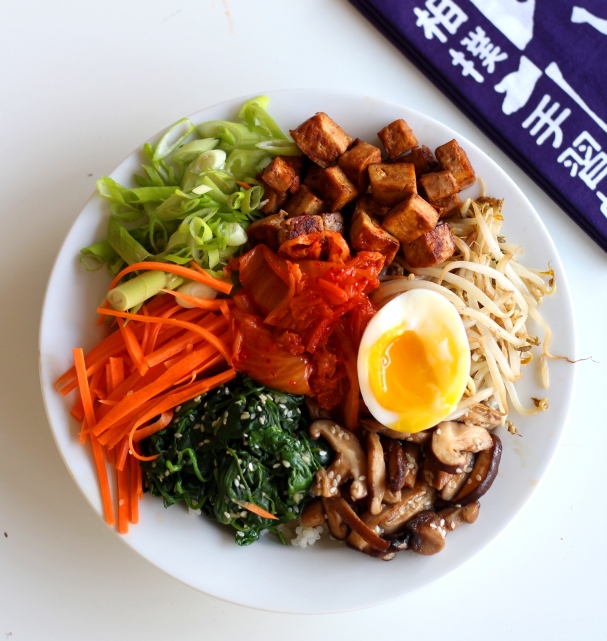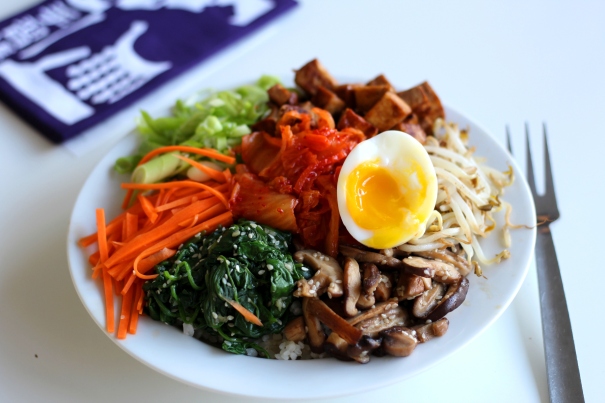This is my first attempt at making bibimbap: a Korean rice dish with an incredibly catchy name. I mean, just try saying it out loud a few times: bi-bim-bap! Instant happiness guaranteed. It’s also pretty tasty. The basic concept is quite simple: put several sauteed vegetables, sliced meat and a raw or fried egg on top of a bowl of rice, stir everything together and eat it. I did things a little differently: I used tofu instead of meat, a soft-boiled egg instead of a raw or fried one, and I also added kimchi, because I still had a jar of it, because it’s Korean and because it’s one of my favourite things.

Unfortunately, I don’t have any Korean napkins, so this beautiful Japanese one will have to do.
Some additional notes: I didn’t add the famous fermented Korean red pepper paste, simply because I couldn’t get hold of it in time and because I hoped the kimchi would make up for it. Traditionally, or so I’m told, bibimbap is often served in a hot ceramic bowl, but I didn’t have that either so my bibimbap was a bit on the cold side. We devised a solution for that though, so hopefully it will be nice and hot next time.
Ingredients (for 2):
200-250 g short-grain rice
2-3 spring onions, finely sliced
250 g Organic firm tofu
1/2 carrot, in match sticks
150 g spinach
150 g shiitake mushrooms
125 g bean sprouts
5 tbsp kimchi
3 cloves of garlic
sesame oil
sesame seeds
salt
soy sauce
2 dried chillies
2 soft-boiled eggs (5 minutes)

- Wash the rice,then bring it to the boil with the correct amount of water (250 g rice needs 350 ml water). When the water boils, turn down the heat, put on the lid and simmer for 10 minutes. Take off the heat and leave to stand (preferably with a large tea cosy) covered for another 15 minutes.
- Slice the spring onions.
- Slice the carrot, add plenty of salt and set aside.
- Boil the eggs for 5 minutes, submerge in very cold water and put them in an oven glove to keep warm.
- Drain the tofu, dice into small cubes and fry them on high heat in a layer of sesame oil. Add a crumbled dried chilli. When the tofu cubes are golden brown on all sides, add soy sauce, allow the tofu to caramelise and add a crushed clove of garlic at the last minute.
- Sautée the shiitake mushrooms in sesame oil, add a crumbled chilli, soy sauce and sesame seeds.
- Briefly sautée the spinach in sesame oil until it begins to wilt, add salt sesame seeds and 2 cloves of garlic right at the end.
- Stir-fry the bean sprouts with sesame oil (yes it’s in everything!)
- Now you’ve got all your toppings together, it’s time to assemble everything, and this is the tricky bit. The best thing you can probably do (I will try this next time) if you don’t have a hot ceramic bowl is to heat a large wok on low to medium heat and add a little sesame oil.
- Fluff up the rice with a fork and add it to the wok. Add all your toppings, wait till the botttom layer of rice starts to crackle and then stir everything. Heat through for a bit and eat.
- If you don’t want to lose the probiotic qualities of the kimchi it shouldn’t be heated, but it will cool off your dish.
- Soft-boiled eggs are still very fragile so they have to be peeled very carefully. Add them on top or stir them through the rice.

My daughter and I do this one together. Great time with her but it helps having two sets of hands. 🙂
LikeLike
My daughter is Korean and we’ve made several Korean dishes. Kogumajan is my favorite. At Christmas this year we deviated from tradition and made Bulgogi, and then Mandu on New Year’s Eve (a Korean tradition as per my Korean aunt). Both were a hit. We have yet to try Bibimbap but it’s one of my daughter’s favorites when we eat Korean food out. Thanks for these wonderful photos. 🙂
LikeLiked by 1 person
Thanks for your comment, Karen! I’m not super familiar with Korean food (yet!), but love the things I have tried so far. Will definitely have to try bulgogi and kogumajan (what is it? I couldn’t find it online) sometime in the future. Coincidentally, I’m making a Korean dinner for some friends who are coming over for dinner tomorrow, so I’m definitely working on expanding my Korean repertoire!
LikeLiked by 1 person
I am probably not spelling it correctly. Kogumajan is parboiled yams (the orange ones), then they are sliced to about 1/4 inch. They are dipped in both egg and flour and then pan fried. They are TO DIE FOR alone, but the dipping sauce is fabulous. It’s soy sauce, fresh ginger, sprigs of green onion, red pepper flakes. There may be another ingredient (sesame oil?) but my book is downstairs. This takes a while because there are several steps–and it’s messy–but very worth the time. Good luck!
LikeLiked by 1 person
That sounds amazing! Might have to add those to the menu tomorrow, and if that doesn’t work out I will at least make them very soon! Thanks for the explanation, you’ve made me very hungry 😉
LikeLiked by 1 person
Looks delicious. Just posted something about the same topic 🙂
Ali”Fox”
LikeLiked by 1 person
Thanks! Your site doesn’t seem to exist yet, though.
LikeLiked by 1 person
Oh gosh. Thanks!! You’re the first one to tell me… have done some changes, hope it’s visible now!!!
LikeLiked by 1 person
Haha, you’re welcome. I checked it out again, and it’s there now! And the bibimbap you ate looked delicious!
LikeLiked by 1 person
Aw you’re so sweet! Thanks for your help!!!
LikeLike
Yums! Looks delicious! Korean food is my favourite! Thanks for sharing this.
LikeLiked by 1 person
Thank you! It was a bit of an experiment, but I really liked it as well. And Korean food is pretty great, I should try and make it more often :)!
LikeLiked by 1 person
So…I always have trouble pronouncing this dish. Is the accent on the first or second syllable? Language difficulties aside, I love this dish but have never had a vegetarian version. The fried soy-garlic tofu cubes sound like the perfect substitute for meat. It looks so good!
LikeLiked by 1 person
Haha, yeah it is a bit of tongue twister :p. I’m not Korean, but apparently the stress is on the second syllable, so it’d be “Bee- Beeeeem-Bap”. I’m not normally a massive fan of firm tofu, but these cubes were soo tasty and moreish! You totally won’t miss the meat.
LikeLike
Oh, the “i’s” are “e’s”! I was so way off…
LikeLiked by 1 person
I love korean food!! Will love to try making bibimbap at home. Thank you for the recipe
LikeLiked by 1 person
You’re welcome! Korean food is one of those cuisines I still have to explore a bit more, but the things I have tasted so far tell me that that exploration is going to be pretty delicious! 🙂
LikeLiked by 1 person